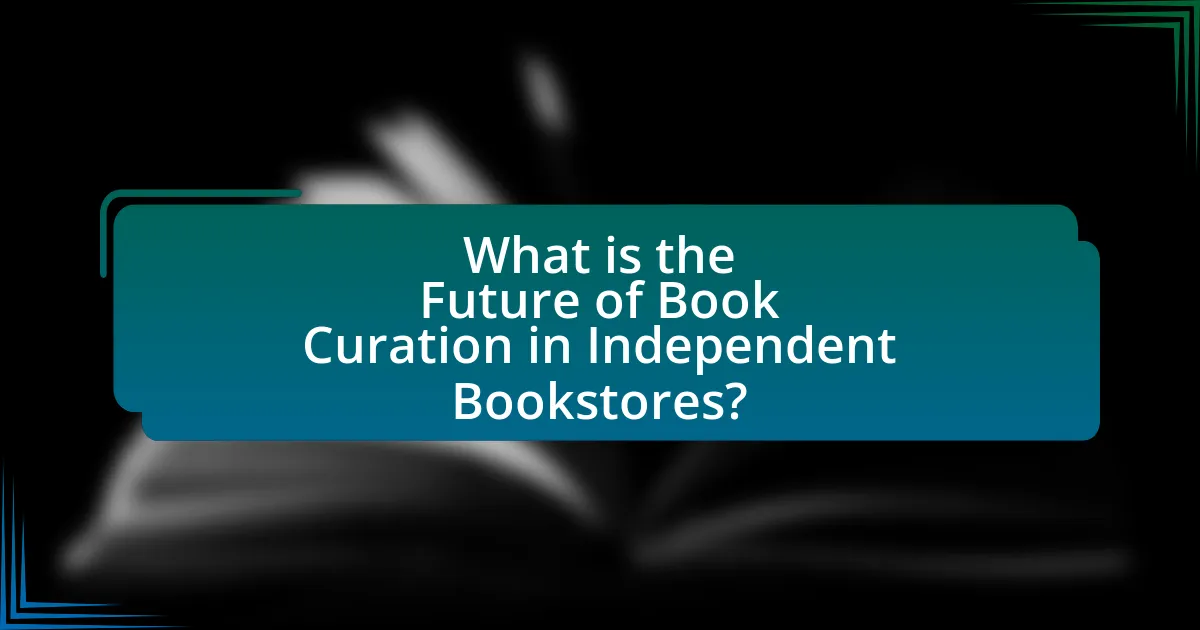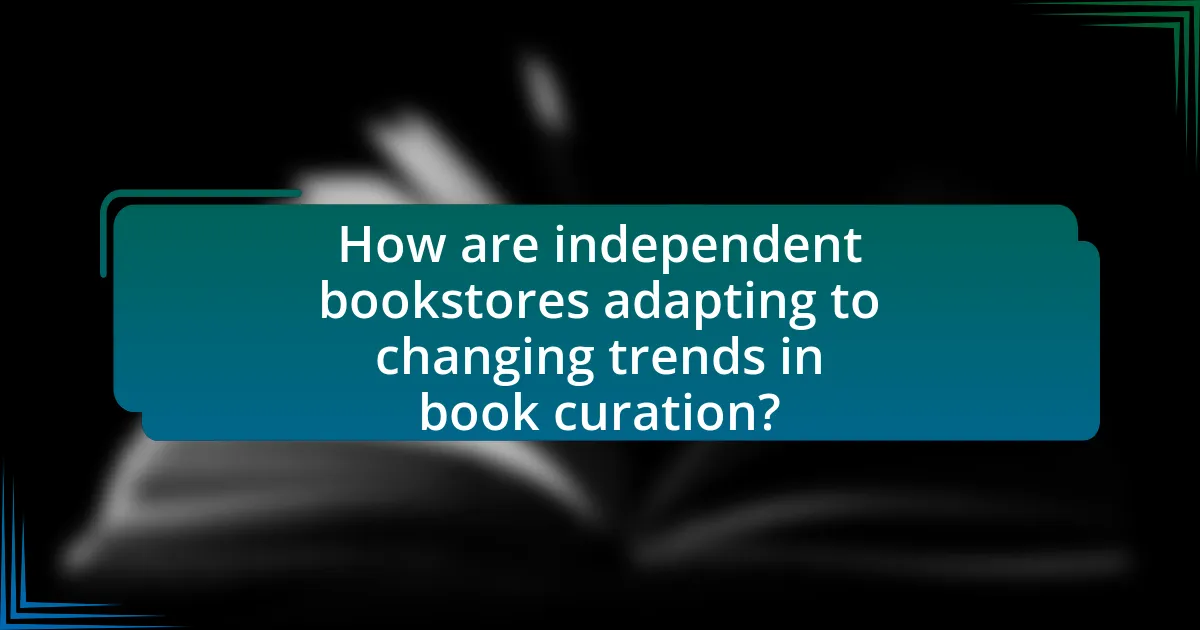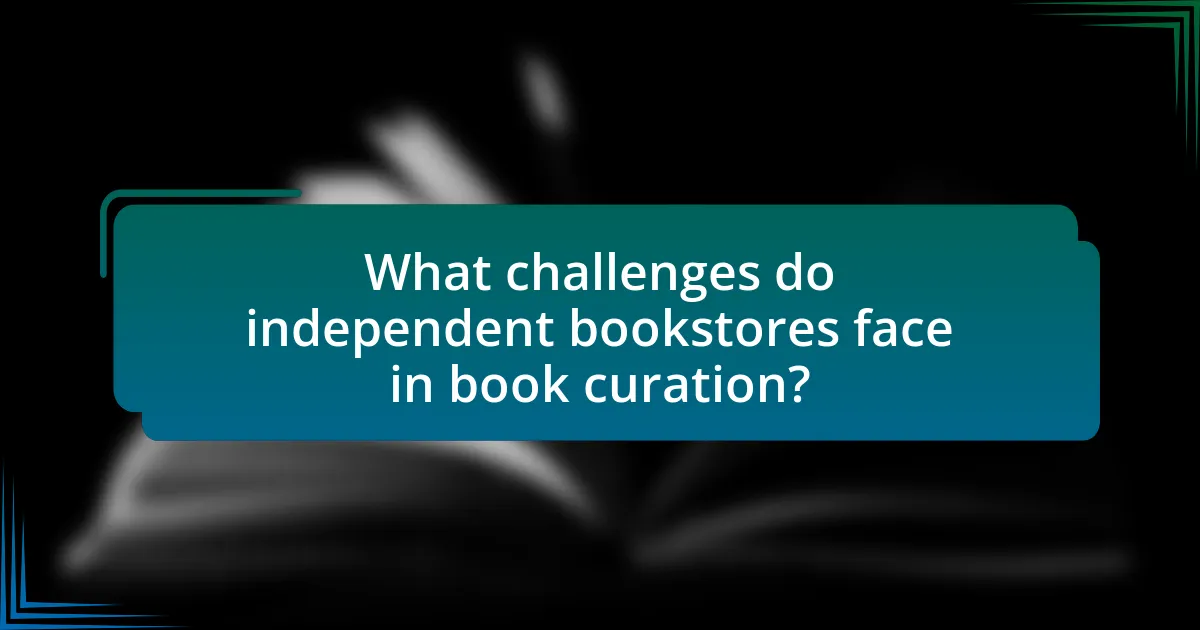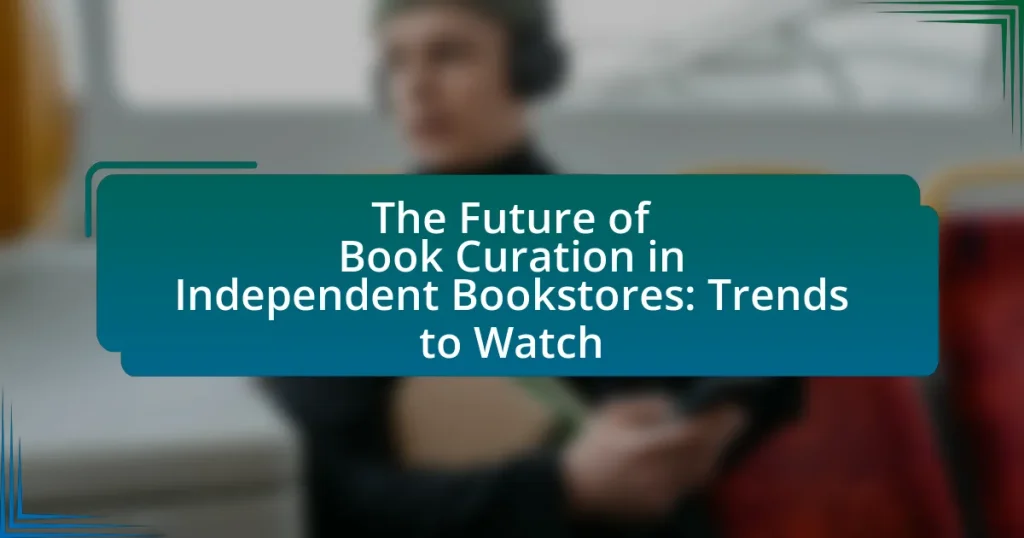The article focuses on the future of book curation in independent bookstores, emphasizing the shift towards personalized experiences and community engagement. It outlines how independent bookstores are utilizing data analytics and customer feedback to curate selections that resonate with local audiences, highlighting the importance of fostering relationships with customers. Key elements of effective curation, differences between independent bookstores and larger retailers, and the role of technology in shaping curation practices are discussed. Additionally, the article addresses challenges faced by independent bookstores, such as financial constraints and competition from online retailers, while providing strategies for enhancing curation and community involvement.

What is the Future of Book Curation in Independent Bookstores?
The future of book curation in independent bookstores is increasingly focused on personalized experiences and community engagement. As consumer preferences shift towards unique and tailored offerings, independent bookstores are leveraging data analytics and customer feedback to curate selections that resonate with local audiences. For instance, a 2022 survey by the American Booksellers Association indicated that 70% of independent bookstores reported an increase in customer interest for curated book recommendations based on individual tastes. This trend highlights the importance of fostering relationships with customers and creating a sense of belonging, which is essential for the sustainability of independent bookstores in a competitive market.
How is book curation defined in the context of independent bookstores?
Book curation in the context of independent bookstores is defined as the selective process of choosing and organizing books to create a tailored and meaningful collection that reflects the store’s identity and meets the interests of its community. This practice involves not only the selection of titles based on quality and relevance but also the arrangement and presentation of books to enhance customer experience and engagement. Independent bookstores often prioritize unique, diverse, and local authors, which distinguishes their curated collections from larger retailers. This approach fosters a personal connection between the bookstore and its customers, contributing to the store’s role as a cultural hub within the community.
What are the key elements of effective book curation?
The key elements of effective book curation include a deep understanding of the target audience, a diverse selection of titles, and the ability to create thematic displays that engage readers. Understanding the audience allows curators to select books that resonate with their interests and preferences, which is essential for fostering a loyal customer base. A diverse selection ensures that various genres and voices are represented, appealing to a broader demographic and enhancing the bookstore’s reputation as an inclusive space. Thematic displays, which can be based on current events, seasonal trends, or specific topics, help to create an inviting atmosphere that encourages exploration and discovery among customers.
How does curation differ between independent bookstores and larger retailers?
Curation in independent bookstores focuses on personalized selections that reflect the tastes and interests of local communities, while larger retailers prioritize mass-market appeal and bestsellers. Independent bookstores often feature curated collections based on staff recommendations, local authors, and niche genres, fostering a unique shopping experience. In contrast, larger retailers utilize data analytics to stock titles that maximize sales potential, often leading to a more homogenized inventory. This difference is evident in the way independent bookstores host events and author signings that cater to specific audiences, whereas larger retailers may rely on national marketing campaigns to drive sales.
Why is book curation important for independent bookstores?
Book curation is important for independent bookstores because it enhances customer experience and fosters community engagement. By carefully selecting and organizing books, independent bookstores can create a unique identity that differentiates them from larger retailers and online platforms. This curated approach not only attracts customers seeking personalized recommendations but also encourages local authors and niche genres, thereby supporting the local literary ecosystem. Research indicates that 70% of consumers prefer shopping at independent bookstores for their curated selections, highlighting the value of tailored offerings in driving sales and customer loyalty.
What role does curation play in customer experience?
Curation plays a critical role in enhancing customer experience by personalizing and streamlining the selection process for consumers. In independent bookstores, effective curation helps to create a tailored shopping environment that resonates with individual preferences, making it easier for customers to discover books that align with their interests. Research indicates that 70% of consumers are more likely to purchase a product when they feel it has been specifically chosen for them, highlighting the importance of curation in driving sales and customer satisfaction. By thoughtfully selecting and presenting books, independent bookstores can foster a deeper connection with their clientele, ultimately leading to increased loyalty and repeat visits.
How can curation influence sales and community engagement?
Curation can significantly influence sales and community engagement by enhancing the shopping experience and fostering a sense of belonging among customers. When independent bookstores curate their selections thoughtfully, they create a tailored environment that resonates with their target audience, leading to increased customer loyalty and repeat purchases. For instance, a study by the American Booksellers Association found that 70% of customers prefer shopping at independent bookstores due to their personalized recommendations and curated collections. This personalized approach not only drives sales but also encourages community interaction through events, book clubs, and discussions centered around curated themes, thereby strengthening the bookstore’s role as a community hub.
What trends are shaping the future of book curation in independent bookstores?
The future of book curation in independent bookstores is being shaped by trends such as personalized recommendations, community engagement, and the integration of technology. Personalized recommendations are increasingly important as bookstores leverage customer data to tailor selections, enhancing the shopping experience. Community engagement is also vital, with bookstores hosting events and book clubs that foster local connections and encourage customer loyalty. Additionally, the integration of technology, including online sales platforms and social media marketing, allows independent bookstores to reach broader audiences while maintaining their unique identity. These trends reflect a shift towards creating a more interactive and customer-focused environment in independent bookstores.
How is technology impacting book curation practices?
Technology is significantly transforming book curation practices by enabling data-driven selection and personalized recommendations. Digital platforms and algorithms analyze reader preferences and trends, allowing curators to tailor selections that resonate with specific audiences. For instance, online retailers like Amazon utilize sophisticated algorithms to suggest books based on user behavior, which influences how independent bookstores curate their inventory to meet consumer demand. Additionally, social media platforms facilitate community engagement and feedback, further informing curation strategies. This shift towards technology-driven curation not only enhances the relevance of book selections but also improves sales and customer satisfaction in independent bookstores.
What are the emerging themes in reader preferences and curation?
Emerging themes in reader preferences and curation include a growing demand for personalized recommendations, an interest in diverse and inclusive literature, and an increasing reliance on digital platforms for discovery. Personalized recommendations are driven by algorithms and curated lists that cater to individual tastes, as evidenced by the success of platforms like Goodreads and Bookstagram. The interest in diverse literature reflects a societal shift towards inclusivity, with readers actively seeking books that represent various cultures, identities, and experiences. Additionally, the reliance on digital platforms is supported by statistics showing that over 50% of readers discover new books through social media and online communities, highlighting the importance of these channels in modern curation practices.

How are independent bookstores adapting to changing trends in book curation?
Independent bookstores are adapting to changing trends in book curation by embracing personalized recommendations and community engagement. These bookstores are increasingly utilizing data analytics to understand customer preferences, allowing them to curate selections that resonate with local interests. For instance, many independent bookstores now host author events, book clubs, and themed displays that reflect current social issues or popular genres, fostering a sense of community and connection among readers. Additionally, they are leveraging social media platforms to promote curated lists and engage with customers directly, which enhances their visibility and relevance in a competitive market. This approach not only strengthens customer loyalty but also positions independent bookstores as vital cultural hubs in their communities.
What strategies are bookstores implementing to enhance curation?
Bookstores are implementing personalized recommendations and thematic displays to enhance curation. By utilizing customer data and preferences, bookstores can tailor selections that resonate with individual readers, thereby increasing engagement and sales. Additionally, thematic displays, often centered around current events or popular genres, attract attention and guide customers through curated experiences. This strategy is supported by research indicating that personalized shopping experiences can lead to a 20% increase in customer satisfaction and loyalty, as noted in a study by the National Retail Federation.
How are bookstores utilizing social media for curation?
Bookstores are utilizing social media for curation by actively engaging with their audience through tailored content that highlights specific books, genres, and author events. This engagement includes posting curated reading lists, sharing book reviews, and promoting local author signings, which fosters a community around literature. For instance, independent bookstores often use platforms like Instagram and Facebook to showcase visually appealing book displays and themed recommendations, which can lead to increased foot traffic and online sales. Additionally, data from a 2022 survey by the American Booksellers Association indicates that 70% of independent bookstores report using social media to connect with customers and promote curated selections, demonstrating its effectiveness in enhancing customer engagement and driving sales.
What partnerships are being formed to improve curation efforts?
Partnerships between independent bookstores and local authors, publishers, and community organizations are being formed to enhance curation efforts. These collaborations aim to create tailored book selections that reflect local interests and promote regional literature. For instance, initiatives like “Local Author Spotlights” allow bookstores to feature works from nearby writers, fostering community engagement and supporting local talent. Additionally, partnerships with publishers enable bookstores to access exclusive titles and curated collections, enhancing the diversity of their offerings. Such strategic alliances are essential for independent bookstores to remain relevant and responsive to their communities’ reading preferences.
How are customer demographics influencing curation choices?
Customer demographics significantly influence curation choices by guiding independent bookstores in selecting titles that resonate with their target audience. For instance, age, gender, and cultural background shape preferences for genres, themes, and authors, leading bookstores to curate collections that reflect the interests and values of their community. Research indicates that millennials and Gen Z readers prefer diverse and inclusive literature, prompting bookstores to prioritize these titles in their offerings. Additionally, demographic data can reveal trends such as increased interest in self-help and wellness books among older adults, influencing inventory decisions. Thus, understanding customer demographics enables bookstores to tailor their curation strategies effectively, ensuring relevance and engagement with their clientele.
What specific needs do younger readers have regarding curation?
Younger readers have specific needs regarding curation that include personalized recommendations, diverse representation, and accessibility to various formats. Personalized recommendations are crucial as younger readers often seek tailored content that aligns with their interests and reading habits, which can be supported by data showing that 70% of millennials prefer personalized experiences in retail. Diverse representation is essential, as younger audiences increasingly demand books that reflect a variety of cultures, identities, and experiences, evidenced by the rise in popularity of diverse authors and stories in recent years. Additionally, accessibility to various formats, such as audiobooks and e-books, is important, as studies indicate that younger readers are more likely to engage with multiple formats, with 50% of Gen Z readers preferring digital formats over print. These needs highlight the importance of adaptive curation strategies in independent bookstores to meet the evolving preferences of younger readers.
How are diverse voices being represented in curated selections?
Diverse voices are represented in curated selections through intentional inclusion of authors from various backgrounds, cultures, and experiences. Independent bookstores are increasingly prioritizing titles by marginalized groups, reflecting a broader societal push for representation in literature. For instance, data from the Cooperative Children’s Book Center indicates that only 10% of children’s books published in recent years feature characters of color, highlighting the need for more diverse narratives. By actively seeking out and promoting these works, bookstores contribute to a richer literary landscape that resonates with a wider audience.

What challenges do independent bookstores face in book curation?
Independent bookstores face significant challenges in book curation, primarily due to limited resources and competition from larger retailers. These bookstores often operate with smaller budgets, restricting their ability to stock a diverse range of titles and invest in marketing efforts that could attract customers. Additionally, they contend with the dominance of online giants like Amazon, which can offer lower prices and a wider selection, making it difficult for independent stores to compete effectively. According to a 2021 report by the American Booksellers Association, independent bookstores have seen a resurgence, but they still struggle with inventory management and the need to curate selections that resonate with local communities while also appealing to broader trends in the publishing industry.
How do financial constraints affect curation decisions?
Financial constraints significantly limit the ability of independent bookstores to curate diverse and extensive book selections. When budgets are tight, bookstores often prioritize bestsellers and popular titles over niche or emerging authors, which can lead to a homogenized inventory. Research indicates that 70% of independent bookstores report financial limitations as a primary factor influencing their purchasing decisions, resulting in reduced opportunities for unique or local authors to be featured. This trend not only affects the variety available to consumers but also impacts the overall cultural landscape by sidelining diverse voices in literature.
What are the implications of limited shelf space on curation?
Limited shelf space significantly impacts curation by forcing independent bookstores to prioritize which titles to display. This constraint leads to a more selective process, where curators must evaluate books based on factors such as popularity, sales potential, and thematic relevance to their audience. For instance, a study by the American Booksellers Association indicates that independent bookstores often rely on customer preferences and local trends to make these decisions, which can result in a narrower range of available titles. Consequently, limited shelf space can enhance the focus on quality over quantity, fostering a curated experience that reflects the unique identity of the bookstore while potentially excluding lesser-known or niche titles.
How can bookstores overcome challenges related to inventory management?
Bookstores can overcome challenges related to inventory management by implementing advanced inventory tracking systems and utilizing data analytics. These systems allow bookstores to monitor stock levels in real-time, reducing the risk of overstocking or stockouts. For instance, a study by the National Retail Federation found that retailers using inventory management software saw a 20% increase in inventory accuracy. Additionally, employing data analytics helps bookstores understand customer preferences and sales trends, enabling them to make informed purchasing decisions. This strategic approach not only optimizes inventory levels but also enhances customer satisfaction by ensuring popular titles are readily available.
What competition do independent bookstores face in the curation space?
Independent bookstores face significant competition in the curation space from online retailers, particularly large platforms like Amazon, which offer vast selections and personalized recommendations through algorithms. These online giants leverage extensive data analytics to curate book selections that appeal to individual consumer preferences, making it challenging for independent bookstores to compete on variety and convenience. Additionally, independent bookstores also contend with other local retailers and specialty shops that may offer curated selections, as well as subscription services that provide tailored book deliveries, further fragmenting the market for curated book offerings.
How do online retailers impact the curation strategies of independent bookstores?
Online retailers significantly influence the curation strategies of independent bookstores by shifting consumer expectations and preferences. Independent bookstores are compelled to adapt their selections to compete with the vast inventory and convenience offered by online platforms, often focusing on niche markets, local authors, and curated experiences that online retailers cannot replicate. For instance, a study by the American Booksellers Association found that independent bookstores that emphasize community engagement and personalized service can thrive despite the competition from online giants. This adaptation is essential for maintaining relevance and attracting customers who seek unique and tailored book recommendations.
What role do large publishing houses play in shaping curation trends?
Large publishing houses significantly influence curation trends by controlling the distribution and marketing of books. They often set industry standards through their selection of titles for promotion, which impacts what independent bookstores choose to stock. For instance, major publishers frequently invest in marketing campaigns for specific genres or authors, leading to increased visibility and sales for those titles. This trend is evident in the rise of bestsellers, where large publishers allocate substantial resources to ensure their books dominate the market. Consequently, independent bookstores may feel pressured to align their curation with these trends to remain competitive, often prioritizing titles that have received significant backing from these publishing giants.
What practical tips can independent bookstores implement for effective curation?
Independent bookstores can implement effective curation by focusing on community engagement, diverse selection, and personalized recommendations. Engaging with the local community through events, book clubs, and author signings fosters relationships and encourages customer loyalty. A diverse selection that includes underrepresented voices and genres attracts a broader audience, enhancing the bookstore’s appeal. Personalized recommendations based on customer preferences can create a unique shopping experience, as studies show that tailored suggestions increase customer satisfaction and sales. By combining these strategies, independent bookstores can curate collections that resonate with their clientele and adapt to evolving market trends.
How can bookstores leverage community feedback in their curation process?
Bookstores can leverage community feedback in their curation process by actively soliciting input from local readers through surveys, social media engagement, and community events. This approach allows bookstores to understand the preferences and interests of their customer base, leading to a more tailored selection of titles. For instance, a study by the American Booksellers Association found that independent bookstores that engage with their communities see a 20% increase in customer loyalty, demonstrating the effectiveness of incorporating community insights into inventory decisions. By utilizing feedback mechanisms, bookstores can create a dynamic and responsive curation strategy that reflects the evolving tastes of their patrons.
What best practices should bookstores follow to stay relevant in curation?
Bookstores should prioritize personalized curation, community engagement, and leveraging technology to stay relevant in curation. Personalized curation involves understanding customer preferences through data analysis and tailoring selections to meet those needs, which can enhance customer loyalty and satisfaction. Community engagement can be achieved by hosting local author events, book clubs, and workshops, fostering a sense of belonging and encouraging repeat visits. Additionally, utilizing technology, such as social media and e-commerce platforms, allows bookstores to reach a broader audience and showcase curated selections effectively. These practices are supported by studies indicating that personalized experiences significantly increase customer retention rates and that community-focused events can boost foot traffic by up to 30%.


